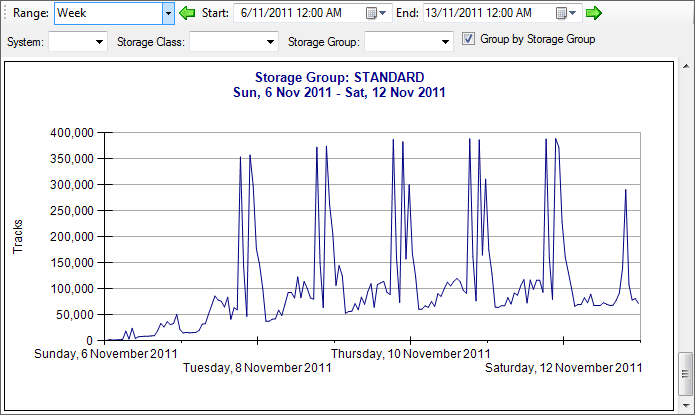This report gives an indication of the space used by new non-VSAM datasets over time. It uses SMF type 14, 15, 17, and 30 records to build a picture of space allocation and release.

The report is not an exact measure of the free space required or used. Due to the limitations of the data included in SMF records, some assumptions need to be made to produce the report and not all allocations are included. The validity of these assumptions will vary from site to site and from storage group to storage group, so you will need to assess the accuracy of the report for your own situation. Typically, the actual free space required would be more than the usage shown in the report.
Despite this, the report can provide a useful picture of space usage. You can see when peaks in allocation activity occur and get an idea of the amount of space allocated. You can zoom in and drill through to other reports to see which jobs and datasets make up the peaks. The information might also be useful for determining the best time to run storage management utilities to monitor free space.
Due to the number of different records types used the report might take some time to run. The Non-VSAM Cumulative Space report is lighter weight with similar but less detailed information. It shows allocations, but does not track when the space is released.
Assumptions and Limitations
Dataset Creation Time
Type 14 and 15 records are generated when a dataset is closed, not when it is allocated. For batch jobs, the report uses the step start time from type 30 records as the time the dataset was allocated. For other work (TSO, STC etc.) it uses the dataset close time. This may mean that some overlapping allocations are not detected, and the peaks shown are lower than in reality.
Dataset Scratch Time
Type 17 records might not be generated for temporary datasets. The REC parameter in SMFPRMxx controls whether they are collected. If no temporary dataset type 17 records are found, the report assumes that batch job temporary datasets are scratched at step end, and other temporary datasets are scratched when closed. Like the dataset creation time, this can result in the space usage shown being lower than the actual usage.
Datasets not Included
Some space allocations are not included in the report. The report only shows NEW non-VSAM dataset allocations, and does not include:
•New or enlarged VSAM datasets
•Enlarged existing datasets e.g. DISP=MOD or new extents added to existing datasets
•Datasets which are allocated but no close SMF record is written e.g. datasets allocated in JCL which are never opened.
Space Released from Existing Datasets
The report does not account for space released for datasets which existed at the beginning of the interval, e.g. GDG generations that roll off or existing datasets migrated by DFHSM. It only shows space allocated and released from NEW dataset allocations. This means that typically, the report will show an upward trend in space usage, particularly at the beginning of the interval, even if the actual consumption is stable. For absolute information about the free space in the storage groups, use the usual storage management utilities e.g. DCOLLECT.
Assigning Storage Groups
Type 14 and 15 records include the SMS storage class, but not the storage group. The storage group is obtained by mapping DASD volumes to storage groups using type 74 subtype 1 records. If type 74 records are not available, the information will be grouped by storage class and storage group filtering is not possible.
Report Parameters
Parameter |
Description |
System |
The SMF ID of the system that wrote the record. |
Storage Class |
Filter by storage class. Use - (a single dash) to show entries with no storage class. |
Storage Group |
Filter by storage group. Use - (a single dash) to show entries with no storage group. |
Group by Storage Group |
Controls whether the allocations are grouped by Storage Group (by mapping volumes to storage groups using type 74 subtype 1 records), or Storage Class from the type 14/15 records. Allocations where the storage group cannot be determined from the type 74 records (either the records are not present, or a storage group for the volume is not found) will be grouped by storage class even if this option is selected. |
SMF records used for this report
Type |
Subtype |
14 |
|
15 |
|
17 |
|
30 |
2 |
30 |
4 |
30 |
5 |
74 |
1 |
Drill Through
Click on a chart in this report to drill through to the Non-VSAM SMS Information report for that storage class/storage group and time interval.